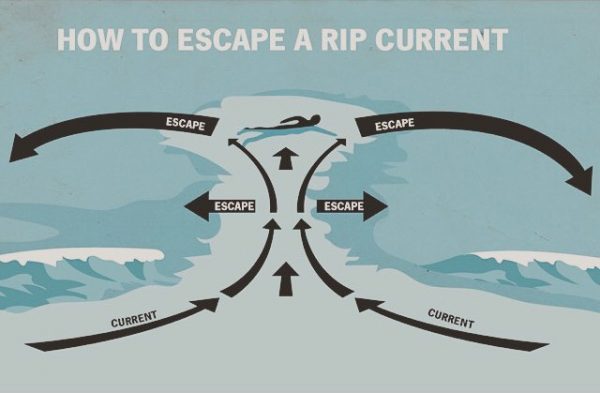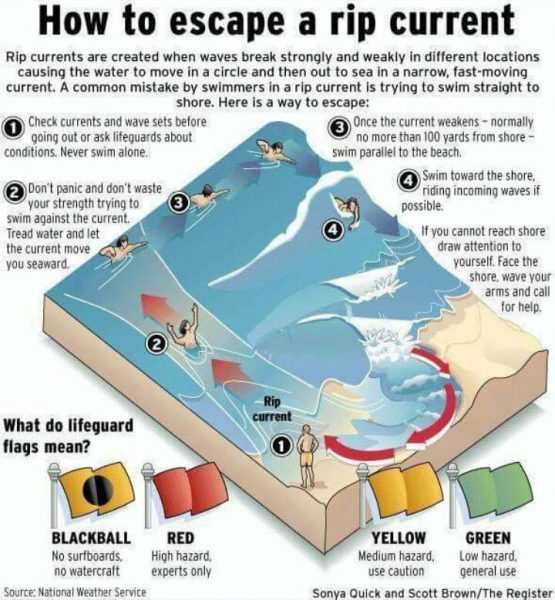How can I avoid a riptide?
If you’re at a public beach with lifeguards, there are usually warning if there have been rip currents occurring that day. You can also ask the lifeguard on duty if there have been any riptides reported that day.
- Keep your feet on the bottom as much as possible when swimming in surf conditions. Rip currents can occur in any ocean or lake where surf conditions (breaking waves) exist. Keeping your feet firmly on the lake or sea floor will help you to avoid being swept out to sea by a rip current.
- Remain calm if a rip current begins to pull you away from shore. If you get caught in a rip current, your first instinct will likely be to panic. Don’t worry, you can escape the current, but you’ll need to keep a clear head about you. Understand that a rip current will probably not pull you underwater; it will only pull you away from the shore.
- Regain your footing if possible. If the current is relatively weak and you’re in shallow water, you will probably be able to touch the bottom again and prevent yourself from being dragged out further. If you can’t touch the bottom, do not struggle against the current. Rip current victims drown because they become exhausted fighting the current. Conserve your energy for methodically swimming and staying afloat.
- Call for help immediately if you can’t swim well. Rip currents are especially dangerous to people who can’t swim or who can’t swim well. If you’re not a good swimmer, get the attention of a lifeguard or of other beachgoers by waving your arms and yelling for help.
- Swim parallel to shore to get out of the current. Being caught in a rip current is like being stuck on a treadmill that you can’t turn off. Luckily, rip currents, like treadmills, are usually pretty narrow–they’re rarely over 100 feet (30.5 m) wide–so you need only get to the side of the rip current (step off the treadmill) to escape. Rather than swim against the current toward shore, swim parallel to the shore. As you do so, the rip current will carry you further away from shore, but remember, don’t panic. Continue swimming parallel to the shore until you are clear of the current–usually no more than 100–150 feet (30.5–45.7 m) down the beach from the point where you entered the water.
Float on your back or tread water if you can’t swim out of the current. If you can’t swim, or if you get tired before you manage to make it out of the current, conserve your energy and stay afloat. Continue to signal for help if there are people present. If you’re alone, just relax and stay afloat until you have enough energy to continue to swim. Rip currents generally subside 50–100 yards (45.7–91.4 m) from the shore, so you’ll eventually stop getting pulled further out.
- Swim toward the shore once you escape the current. When you are out of the current, either because you’ve reached its side or you’ve been carried out far enough for the current to subside, make your way back to shore. It’s generally a good idea to swim diagonally toward shore and away from the current rather than swimming straight back, as the latter method may bring you right back into the current. You may be some distance from shore at this point, so stop and float periodically if you need to rest.
Tips
- Don’t be ashamed to ask for help. If uncertain how to react while in a rip current and a beach lifeguard is nearby, wave at them. It is important to wave with both hands, the universal sign of swimmer’s distress. Beach lifeguards have experience and training with rip currents and are there to help you out.
- Rip currents deserve respect, but you don’t need to fear them. Lifeguards sometimes intentionally swim in them to quickly reach someone beyond the surf, and surfers find them useful to easily get out to catch waves. Lifeguards and surfers, of course, are very proficient swimmers and have experience swimming in surf conditions, so most of us shouldn’t intentionally enter a rip current. That said, if you do get caught in one, remain calm.
- Never swim alone.
- Hapless victims tend to wear themselves out by fighting the rip current by swimming to the shore: remember, swim to the side to escape the tide, which is relatively narrow. Don’t Panic!
- An undertow or rip tide is the same thing as a rip current. Rip current is the most accurate description of the phenomenon. The term undertow, in particular, is misleading: rip currents drag people out to sea, but they don’t drag them underwater.
Warnings
- Rip currents will not always travel perpendicular to the beach, some will travel parallel. Watch the beach to discover which way you are traveling.
- Stay out of rip currents if possible. Heed all posted warnings. When traveling, always make sure there are others swimming at the same beach as you. If not, it may be known to the locals as a dangerous beach.
- Never swim against the current. It will be stronger than you, and it will exhaust you, which could make you drown. Many people that drown may be strong swimmers who think they can swim faster the current.
Latest posts by Stacy Cook (see all)
- Vero Beach Resort - April 26, 2021
- Locations for all Free Little Libraries in Vero Beach - July 16, 2018
- It’s the Little Things at Varietals and More - March 28, 2018


